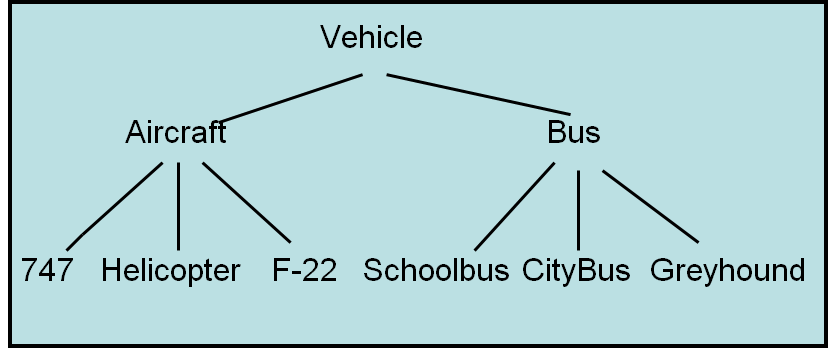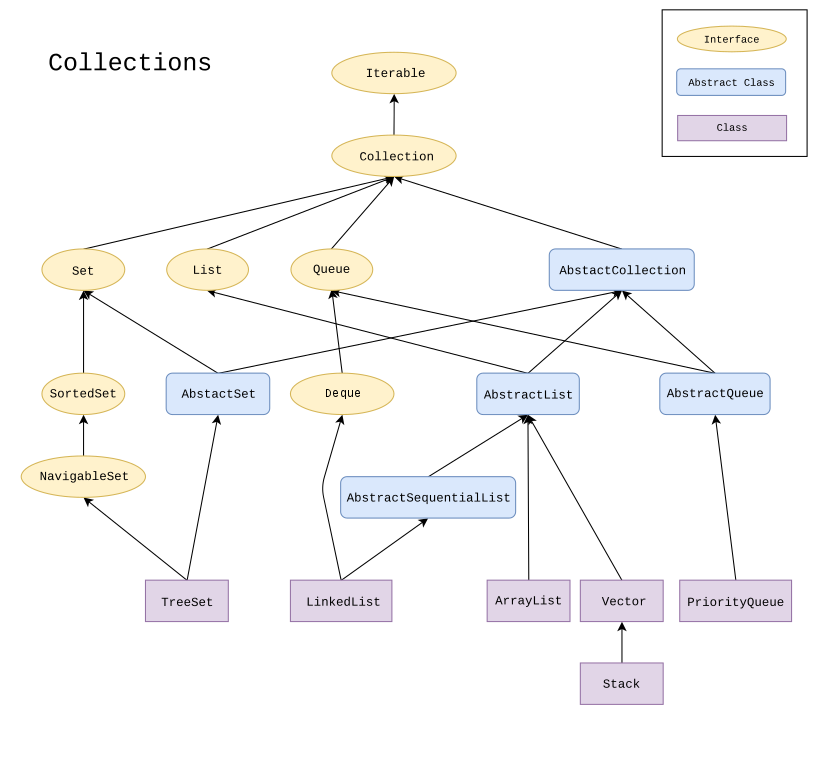17. Inheritance
Inheritance is a way to derive a class from an existing one
This allows the ability to inherit functionality from the base class

Example class hierarchy of elements based on the most general (top) to the least general/most specific (bottom). Moving down the tree, elements become more and more specific. However, when moving down the tree, each element is still a type of the elements above it.

Example class hierarchy for the Bag class and its subtypes — SortedBag and IndexedBag.
This hierarchical thinking exists in everyday life
However, one should be careful not to translate what makes sense in reality to code
17.1. Terminology
The class that is being inherited from is referred to as the superclass
Parent class
Base class
The class that is inheriting from a superclass is called the subclass
Child class
Derived class
When considering the hierarchies, these terms are relative
A
SortedBagis a subclass of aBagA
Bagis a superclass of aIndexedBagAn
Objectis also a superclass ofBag,SortedBag, andIndexedBag
17.2. Object
The
Objectclass is always at the root of the hierarchyEvery class in Java will inherit from the
ObjectclassThis is done automatically; it is not necessary to
extendObjectexplicitly
Child classes inherit everything from their superclasses
This means that all the methods from
Objectare inherited for freetoStringequalshashCode
However, they are typically overridden with class specific functionality if they are to be used
For example, inherited behaviour of
equalschecks if the references are to the same exact objectx.equals(y)checks ifxandyare the same object (same asx == y)
17.3. Collections Example

Visualization of part of Java’s collections’ class hierarchy.
17.3.1. Abstract Class
Notice the Abstract Class designation
An abstract class is one that
Is declared with the
abstractkeywordMay or may not include abstract methods
Method signatures, like interfaces
Cannot be instantiated
May be subclassed/inherited from
May include concrete methods that will be the same among multiple subclasses
Take Java’s AbstractQueue class and its subclass, PriorityQueue
The
AbstractQueuehas several important concrete methods implemented within the abstract classaddaddAllclearelementremoveIt also inherits a bunch from superclasses too
The
PriorityQueueclass, whichextends AbstractQueue, makes direct use of a few of these methodsaddAllelementremove
But the
PriorityQueuealso overrides a few of the methods fromAbstractQueuesince it requires a specific implementationaddclear
If you open the
PriorityQueue.javafileOne cannot find
addAll,element, orremovedwithin it since they are inheritedOne can find the overridden methods
addandclear
17.4. Polymorphism
Polymorphism is the idea that behavior can change depending on the type of the object
Though, the idea of polymorphism is broader than just inheritance
Consider the below
StackexamplesStack<Integer> myStack = new ArrayStack<>();Stack<Integer> myStack = new LinkedStack<>();The reference variables is for something of type
StackYet, it can reference an object of type
ArrayStackorLinkedStackThis is because
ArrayStackis aStackandLinkedStackis aStackHowever, it is not possible to do this
ArrayStack<Integer> myStack = new LinkedStack<>();This is because a
LinkedStackis not anArrayStack
Note
1Stack<Integer> myStack = new LinkedStack<>();
2Object o = myStack;
The data both myStack and o reference has the type LinkedStack. It is the reference variable that’s type
changed (and can change to any supertype). However, the type of the object itself does not change.
Warning
One should be careful with the is a metaphor as it can be abused and cause trouble. Is a is fine if referring to the types, not the things they represent.
17.4.1. Binding
1Stack<Integer> myStack;
2if (randomNumber < 50) {
3 myStack = new ArrayStack<>();
4} else {
5 myStack = new LinkedStack<>();
6}
7
8myStack.push(11);
9myStack.push(22);
10myStack.push(33);
11System.out.println(myStack);
Given the above code, which version of
toStringwould be called?ArrayStack?LinkedStack?
Connecting a call of a method to the actual implementation of the method is called binding
Sometimes this is known at compile time — static binding
Other times, like in the above example, this is not known until runtime — dynamic binding
It is possible to get the type of the object at runtime
myStack.getClass()
17.5. For Next Time
Have a quick look at the JDK specification link (you won’t understand everything, but that’s OK)
Read Chapter 3 Section 3
3 pages